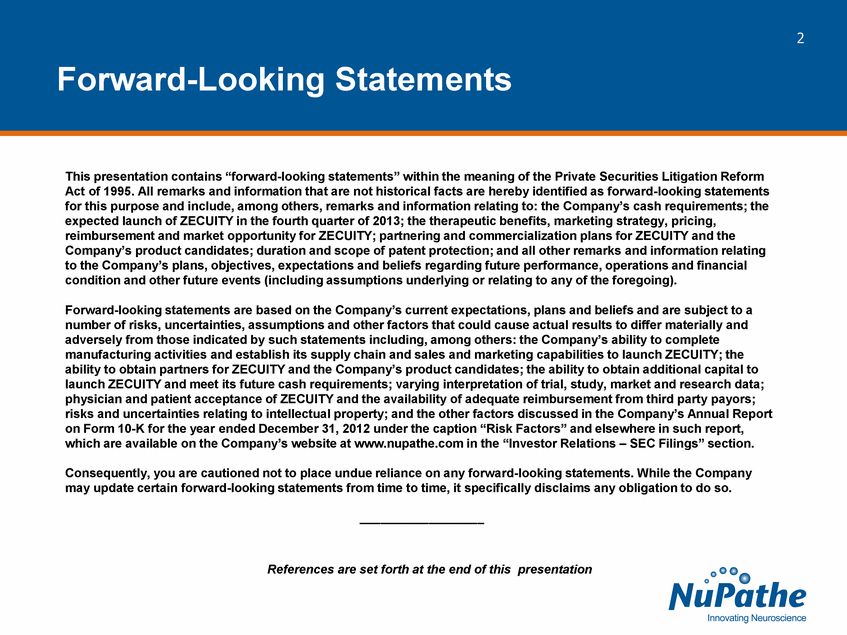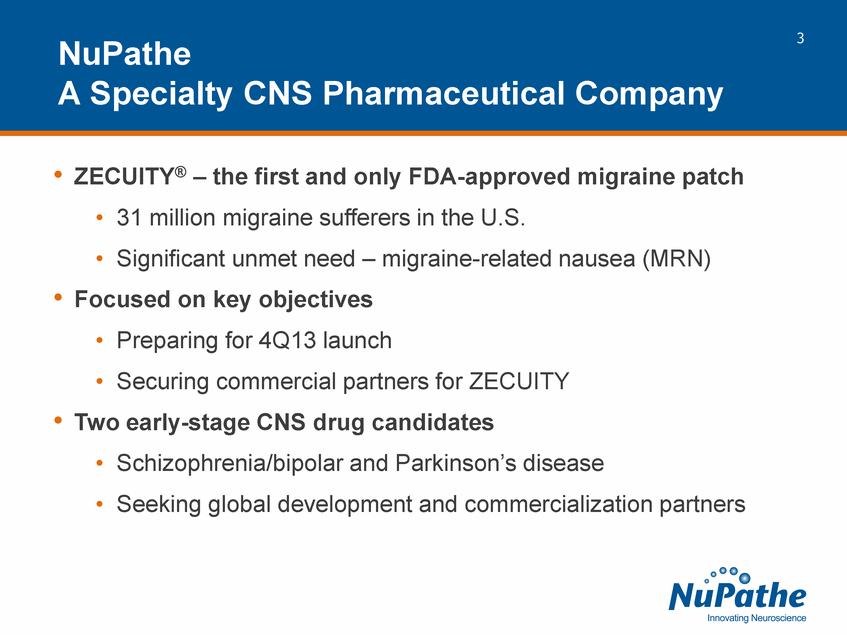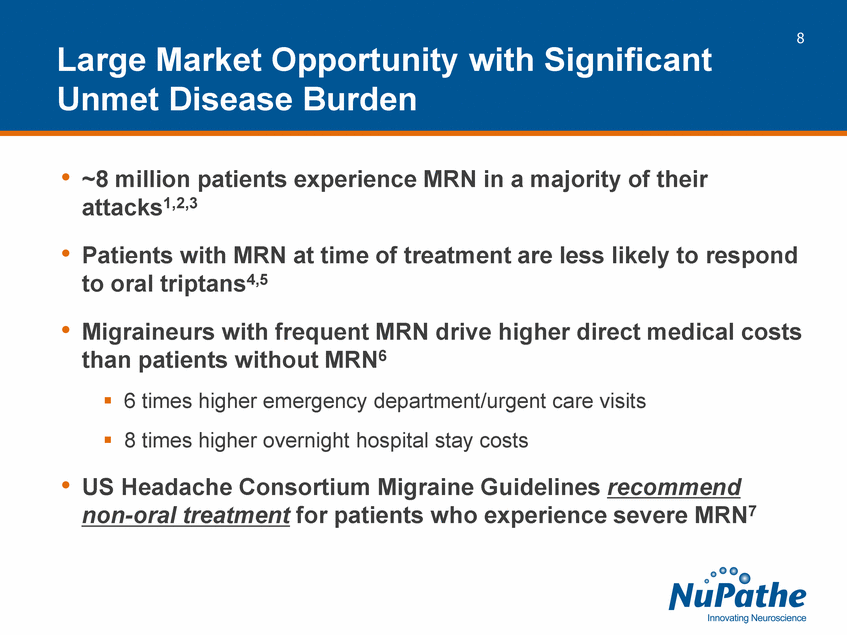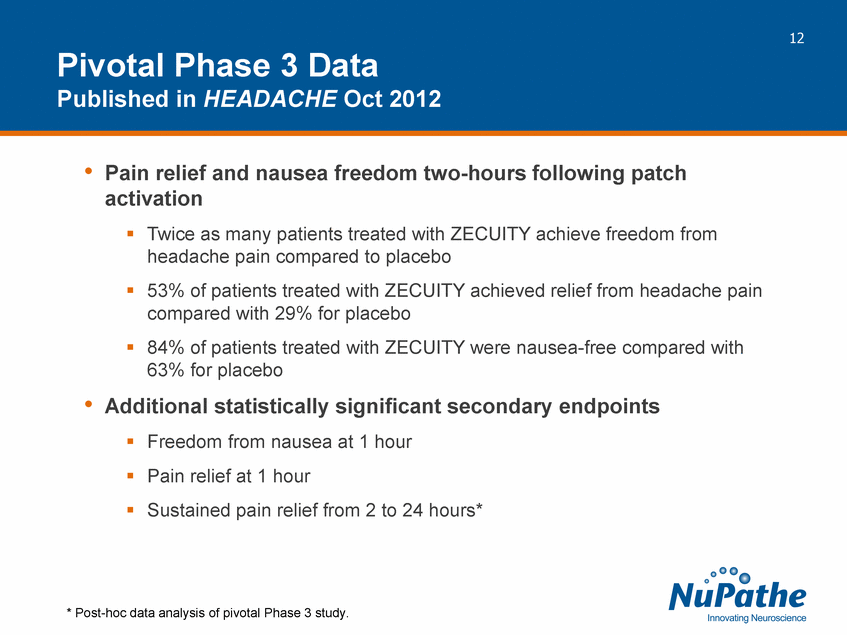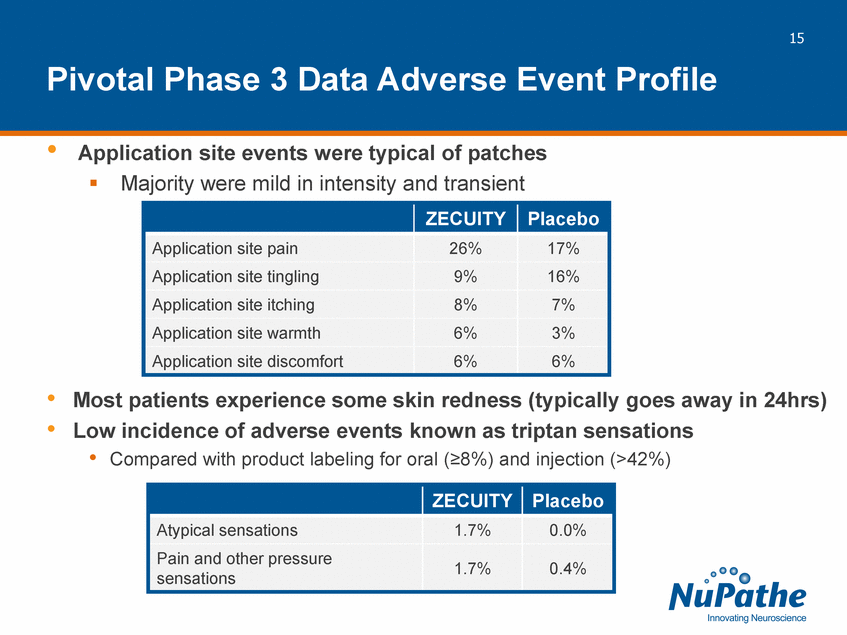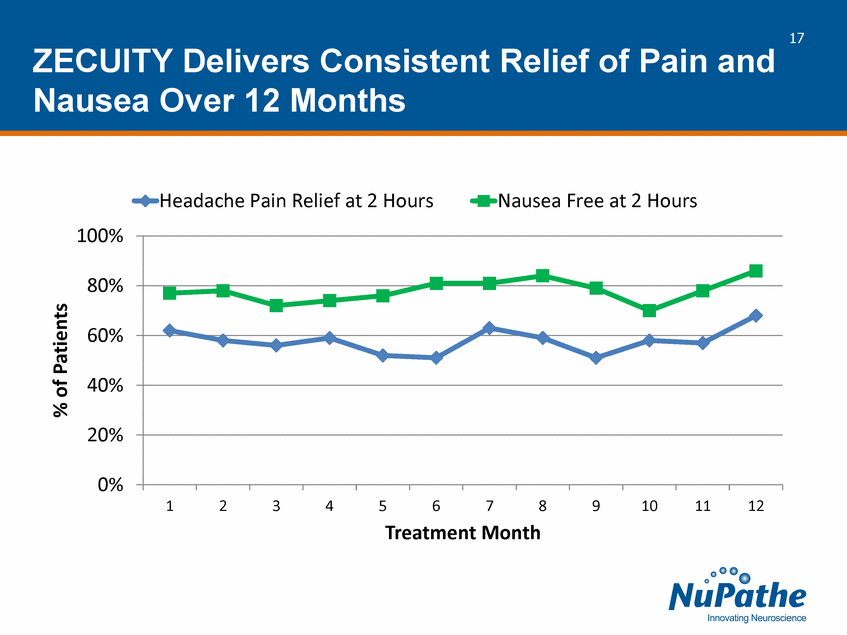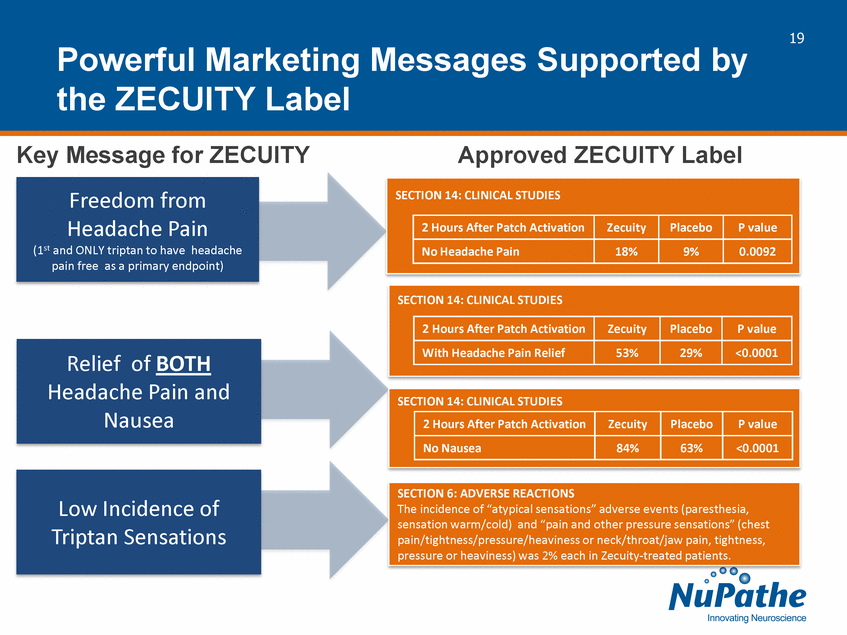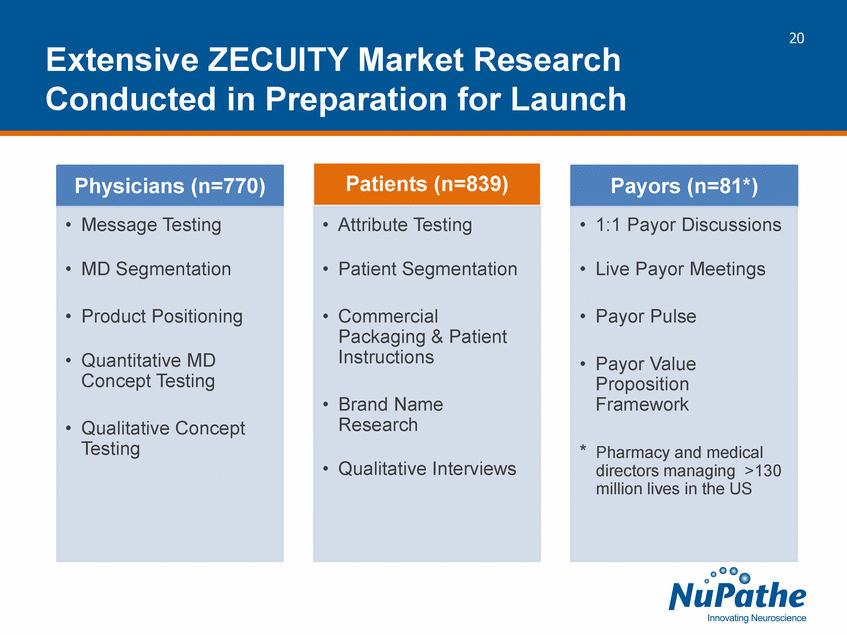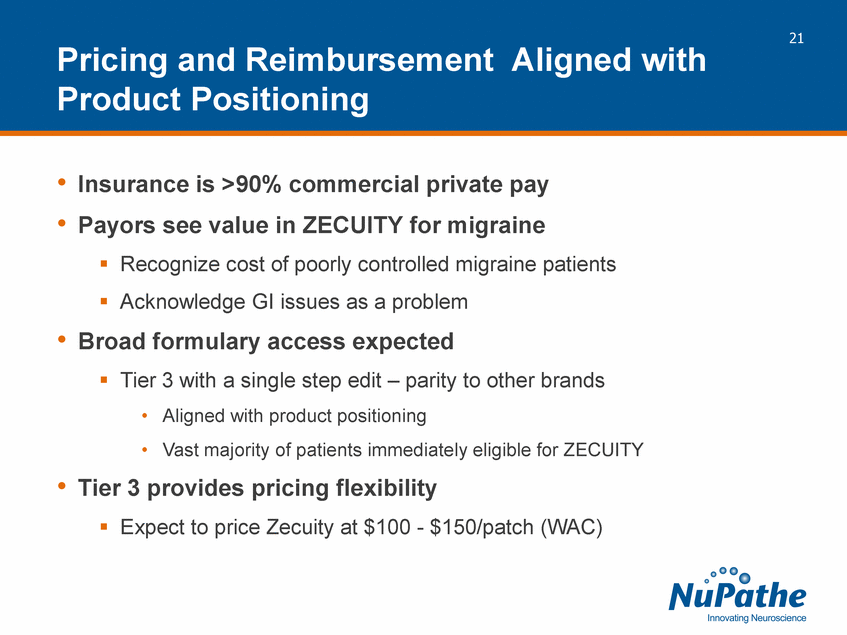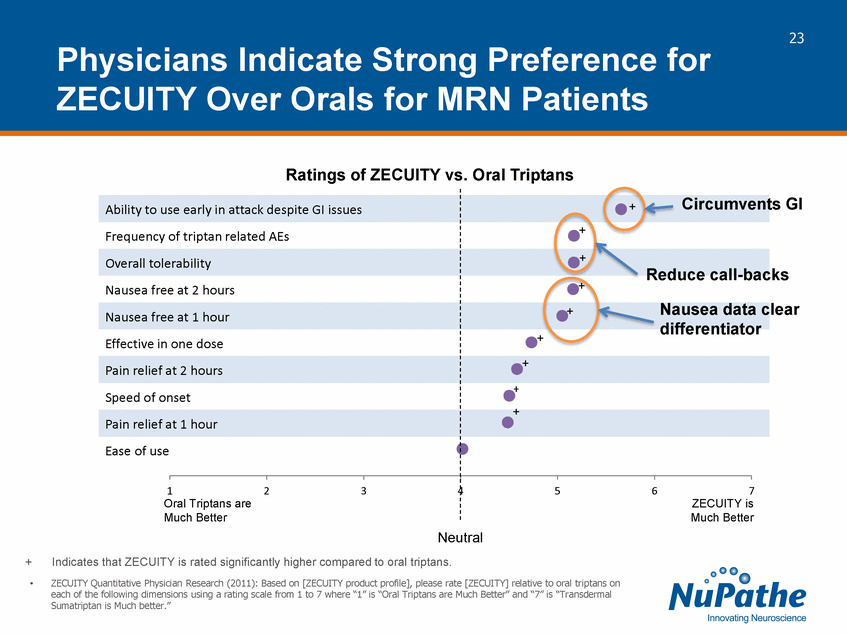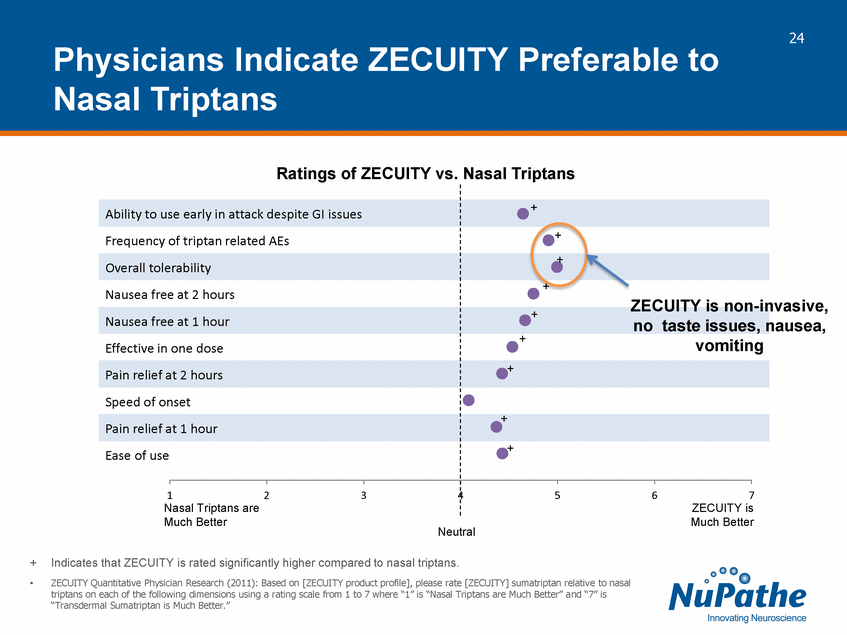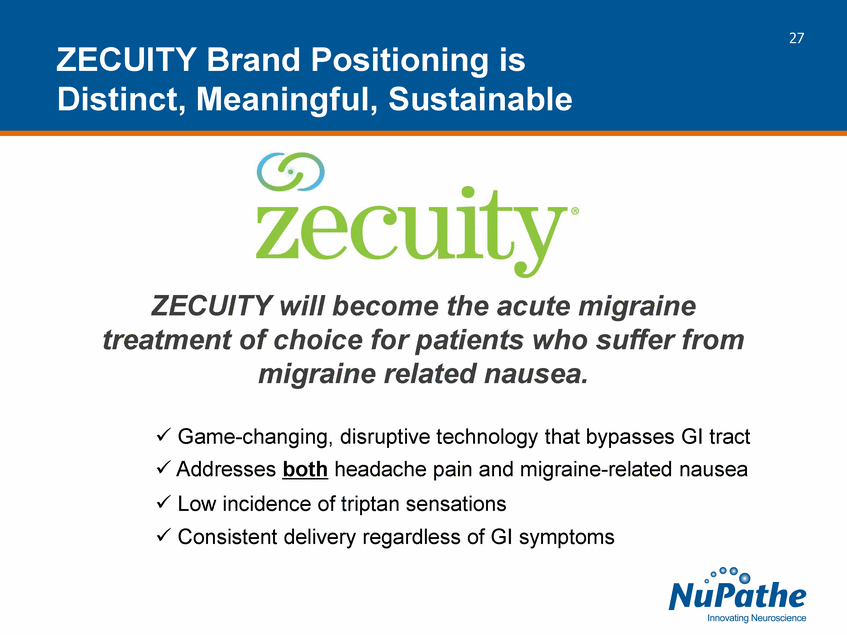Attached files
| file | filename |
|---|---|
| 8-K - 8-K - NUPATHE INC. | a13-20482_18k.htm |
Exhibit 99.1
|
|
Corporate Presentation September 11, 2013 © 2013 NuPathe Inc. All rights reserved. |
|
|
2 Forward-Looking Statements This presentation contains “forward-looking statements” within the meaning of the Private Securities Litigation Reform Act of 1995. All remarks and information that are not historical facts are hereby identified as forward-looking statements for this purpose and include, among others, remarks and information relating to: the Company’s cash requirements; the expected launch of ZECUITY in the fourth quarter of 2013; the therapeutic benefits, marketing strategy, pricing, reimbursement and market opportunity for ZECUITY; partnering and commercialization plans for ZECUITY and the Company’s product candidates; duration and scope of patent protection; and all other remarks and information relating to the Company’s plans, objectives, expectations and beliefs regarding future performance, operations and financial condition and other future events (including assumptions underlying or relating to any of the foregoing). Forward-looking statements are based on the Company’s current expectations, plans and beliefs and are subject to a number of risks, uncertainties, assumptions and other factors that could cause actual results to differ materially and adversely from those indicated by such statements including, among others: the Company’s ability to complete manufacturing activities and establish its supply chain and sales and marketing capabilities to launch ZECUITY; the ability to obtain partners for ZECUITY and the Company’s product candidates; the ability to obtain additional capital to launch ZECUITY and meet its future cash requirements; varying interpretation of trial, study, market and research data; physician and patient acceptance of ZECUITY and the availability of adequate reimbursement from third party payors; risks and uncertainties relating to intellectual property; and the other factors discussed in the Company’s Annual Report on Form 10-K for the year ended December 31, 2012 under the caption “Risk Factors” and elsewhere in such report, which are available on the Company’s website at www.nupathe.com in the “Investor Relations – SEC Filings” section. Consequently, you are cautioned not to place undue reliance on any forward-looking statements. While the Company may update certain forward-looking statements from time to time, it specifically disclaims any obligation to do so. __________________ References are set forth at the end of this presentation |
|
|
3 • ZECUITY® – the first and only FDA-approved migraine patch •31 million migraine sufferers in the U.S. •Significant unmet need – migraine-related nausea (MRN) •Focused on key objectives •Preparing for 4Q13 launch •Securing commercial partners for ZECUITY •Two early-stage CNS drug candidates •Schizophrenia/bipolar and Parkinson’s disease •Seeking global development and commercialization partners NuPathe A Specialty CNS Pharmaceutical Company |
|
|
4 •Game-changing disruptive technology for migraine .Delivers sumatriptan, the #1 prescribed migraine medication .Five Orange-Book listed patents provide protection to April 2029 •Uniquely positioned to address migraine headache pain and MRN .Rapid relief of both headache pain and MRN with a low rate of triptan sensations .MRN impacts half of all migraine sufferers and drives higher headache-related health care utilization and direct costs •Attractive specialist-driven opportunity .~6,000 physicians prescribe 33+ million units of triptans annually •Expected launch in 4Q2013 ZECUITY - First and Only FDA Approved Migraine Patch |
|
|
5 •Intelligent, active transdermal delivery .Microprocessor supports highly controlled and consistent delivery •Multiple safety checks within seconds of activation •Continuous monitors skin resistance and adjusts drug delivery •Delivers 6.5 mg of sumatriptan with minimal patient-to-patient variability .Simple for patients – press a button (no inputs or adjustments) ZECUITY: Game-Changing, Disruptive Technology |
|
|
6 Easy to use, single-use, disposable •Applied to upper arm or thigh during a migraine •Bypasses GI tract •Rapidly delivers sumatriptan ZECUITY: First and Only Migraine Patch |
|
|
7 MRN is a Prominent Component of Migraine Disease Burden 31M 16M 8M 0 5 10 15 20 25 30 35 Adult Migraine Sufferers Diagnosed & Treated MRN in Majority of Attacks U.S. Adults (millions) Core Zecuity Target Patients •Affects females to males 3:13 •Disease of the working class population, 20 – 50 years of age3 1,2 1 3 |
|
|
8 Large Market Opportunity with Significant Unmet Disease Burden •~8 million patients experience MRN in a majority of their attacks1,2,3 •Patients with MRN at time of treatment are less likely to respond to oral triptans4,5 •Migraineurs with frequent MRN drive higher direct medical costs than patients without MRN6 .6 times higher emergency department/urgent care visits .8 times higher overnight hospital stay costs •US Headache Consortium Migraine Guidelines recommend non-oral treatment for patients who experience severe MRN7 |
|
|
9 •Triptan tablets/melts .Patients delay/avoid orals – too nauseated/fear of vomiting1,2,3 .Gastroparesis can impact absorption and response to oral triptans4 •Triptan nasal sprays and injections •Result: Patients frequently switch7 .80% have tried at least two triptans .50% have tried three or more triptans Imitrex Nasal Spray 20mg5 Bad Taste 25% Nausea/Vomiting 14% Imitrex Injection 6mg6 Atypical Sensations* 42% Dizziness/Vertigo 12% *Atypical sensations include tingling, warm/hot sensation, burning sensation, feeling of heaviness, pressure sensation, feeling of tightness, numbness Current Options Often Fail Patients with MRN |
|
|
10 ZECUITY is tailored for migraine patients who suffer from MRN ZECUITY is the Solution |
|
|
11 •Extensive clinical program including more than 800 patients and 10,000 patch applications •Pivotal Phase 3 study (n=530) published in Headache, Oct 2012 •Two 12-month, repeat use, open-label trials (n=662) .NP101-008 published in Headache, April 2012 Excellent Efficacy and Safety Demonstrated through Robust Clinical Program |
|
|
12 •Pain relief and nausea freedom two-hours following patch activation .Twice as many patients treated with ZECUITY achieve freedom from headache pain compared to placebo .53% of patients treated with ZECUITY achieved relief from headache pain compared with 29% for placebo .84% of patients treated with ZECUITY were nausea-free compared with 63% for placebo •Additional statistically significant secondary endpoints .Freedom from nausea at 1 hour .Pain relief at 1 hour .Sustained pain relief from 2 to 24 hours* Pivotal Phase 3 Data Published in HEADACHE Oct 2012 * Post-hoc data analysis of pivotal Phase 3 study. |
|
|
13 Clinical Data – Zecuity and Imitrex® Tablets 57% 68% 65% 20% 40% 60% 80% 100% Placebo Tab Imitrex® 50mg Imitrex® 100mg * * * * ns ns Imitrex® % Patients w/ Headache Pain Relief ZECUITY % Patients w/ Headache Pain Relief Zecuity % Patients w/ Nausea Freedom Imitrex® % Patients w/ Nausea Freedom 29% 53% 20% 40% 60% 80% 100% Placebo Patch ZECUITY 63% 84% 20% 40% 60% 80% 100% Placebo Patch ZECUITY 26% 50% 56% 20% 40% 60% 80% 100% Placebo Tab Imitrex® 50mg Imitrex 100mg * (statistically significant vs. placebo) ns (not statistically significant) 2 Hour Headache Pain Relief1 2 Hour Nausea Freedom1 2 Hour Nausea Freedom2 2 Hour Headache Pain Relief2 No head-to-head study comparing ZECUITY and Imitrex has been performed. |
|
|
14 •TEN is defined as the development of MRN after initiation of treatment •Up to 20% of patients receiving oral triptans experience TEN1 •In ZECUITY pivotal Phase 3, at two hours post- treatment2: .5% of ZECUITY patients had TEN* .14% of placebo patients had TEN* ZECUITY Associated with Substantially Less Treatment Emergent Nausea (TEN) * Post-hoc data analysis of pivotal Phase 3 study. |
|
|
15 Pivotal Phase 3 Data Adverse Event Profile •Application site events were typical of patches .Majority were mild in intensity and transient •Most patients experience some skin redness (typically goes away in 24hrs) •Low incidence of adverse events known as triptan sensations •Compared with product labeling for oral (=>8%) and injection (>42%) ZECUITY Placebo Application site pain 26% 17% Application site tingling 9% 16% Application site itching 8% 7% Application site warmth 6% 3% Application site discomfort 6% 6% ZECUITY Placebo Atypical sensations 1.7% 0.0% Pain and other pressure sensations 1.7% 0.4% |
|
|
16 Two 12-Month Open-Label Trials Confirm Safety of ZECUITY (n=662 patients) •Consistent relief of pain and nausea over 12 months •Very low incidence of triptan sensations (0.9%) •No increased skin irritation with repeat or increased use •Low incidence of allergic contact dermatitis (4%) •12-month completers used 2.5 patches per month |
|
|
17 0% 20% 40% 60% 80% 100% 1 2 3 4 5 6 7 8 9 10 11 12 % of Patients Treatment Month Headache Pain Relief at 2 Hours Nausea Free at 2 Hours ZECUITY Delivers Consistent Relief of Pain and Nausea Over 12 Months |
|
|
18 •Target physicians who treat higher % of MRN .~6,000 headache specialists prescribe 33+ million triptan units annually .Additional ~34,000 physicians prescribe 50+ million triptan units annually •Relentlessly deliver differentiating messages in label .Relief of both headache pain and MRN .Low rate of triptan sensations •Price ZECUITY at parity or premium to existing branded non- orals •Raise market focus on MRN disease burden ZECUITY Marketing Strategy |
|
|
19 Powerful Marketing Messages Supported by the ZECUITY Label Relief of BOTH Headache Pain and Nausea Low Incidence of Triptan Sensations Key Message for ZECUITY Approved ZECUITY Label Freedom from Headache Pain (1st and ONLY triptan to have headache pain free as a primary endpoint) SECTION 14: CLINICAL STUDIES SECTION 14: CLINICAL STUDIES SECTION 6: ADVERSE REACTIONS The incidence of “atypical sensations” adverse events (paresthesia, sensation warm/cold) and “pain and other pressure sensations” (chest pain/tightness/pressure/heaviness or neck/throat/jaw pain, tightness, pressure or heaviness) was 2% each in Zecuity-treated patients. SECTION 14: CLINICAL STUDIES 2 Hours After Patch Activation Zecuity Placebo P value With Headache Pain Relief 53% 29% <0.0001 2 Hours After Patch Activation Zecuity Placebo P value No Headache Pain 18% 9% 0.0092 2 Hours After Patch Activation Zecuity Placebo P value No Nausea 84% 63% <0.0001 |
|
|
20 Extensive ZECUITY Market Research Conducted in Preparation for Launch Physicians (n=770) •Message Testing •MD Segmentation •Product Positioning •Quantitative MD Concept Testing •Qualitative Concept Testing Patients (n=839) •Attribute Testing •Patient Segmentation •Commercial Packaging & Patient Instructions •Brand Name Research •Qualitative Interviews Payors (n=81*) •1:1 Payor Discussions •Live Payor Meetings •Payor Pulse •Payor Value Proposition Framework * Pharmacy and medical directors managing >130 million lives in the US |
|
|
21 •Insurance is >90% commercial private pay •Payors see value in ZECUITY for migraine .Recognize cost of poorly controlled migraine patients .Acknowledge GI issues as a problem •Broad formulary access expected .Tier 3 with a single step edit – parity to other brands •Aligned with product positioning •Vast majority of patients immediately eligible for ZECUITY •Tier 3 provides pricing flexibility .Expect to price Zecuity at $100 - $150/patch (WAC) Pricing and Reimbursement Aligned with Product Positioning |
|
|
22 •Physicians rated ZECUITY superior to oral, nasal, and injectable triptans for MRN patients on key attributes including: .Ability to use early in a migraine attack despite GI issues .Frequency of triptan sensations and overall tolerability .Elimination of nausea at 1 and at 2 hours •77% of MRN patients responded they would ask their physician about the patch Quantitative Research Confirms the Market Opportunity for ZECUITY Physicians (n=409) . Priority segments •Heightened concern about MRN •High interest in prescribing a migraine patch Patients (n=400) .Priority segments •Actively seeking new treatments •Highest % of migraines with nausea |
|
|
23 Physicians Indicate Strong Preference for ZECUITY Over Orals for MRN Patients Ability to use early in attack despite GI issues Frequency of triptan related AEs Overall tolerability Nausea free at 2 hours Nausea free at 1 hour Effective in one dose Pain relief at 2 hours Speed of onset Pain relief at 1 hour Ease of use 1 2 3 4 5 6 7 + Ratings of ZECUITY vs. Oral Triptans Oral Triptans are Much Better ZECUITY is Much Better Neutral + + + + + + + + Circumvents GI Nausea data clear differentiator Reduce call-backs •ZECUITY Quantitative Physician Research (2011): Based on [ZECUITY product profile], please rate [ZECUITY] relative to oral triptans on each of the following dimensions using a rating scale from 1 to 7 where “1” is “Oral Triptans are Much Better” and “7” is “Transdermal Sumatriptan is Much better.” + Indicates that ZECUITY is rated significantly higher compared to oral triptans. |
|
|
24 Physicians Indicate ZECUITY Preferable to Nasal Triptans Ability to use early in attack despite GI issues Frequency of triptan related AEs Overall tolerability Nausea free at 2 hours Nausea free at 1 hour Effective in one dose Pain relief at 2 hours Speed of onset Pain relief at 1 hour Ease of use 1 2 3 4 5 6 7 + Ratings of ZECUITY vs. Nasal Triptans Nasal Triptans are Much Better ZECUITY is Much Better Neutral + + + + + + + + ZECUITY is non-invasive, no taste issues, nausea, vomiting •ZECUITY Quantitative Physician Research (2011): Based on [ZECUITY product profile], please rate [ZECUITY] sumatriptan relative to nasal triptans on each of the following dimensions using a rating scale from 1 to 7 where “1” is “Nasal Triptans are Much Better” and “7” is “Transdermal Sumatriptan is Much Better.” + Indicates that ZECUITY is rated significantly higher compared to nasal triptans. |
|
|
25 Physicians Rate ZECUITY Tolerability and Ease of Use Superior to Injectable Triptans Ability to use early in attack despite GI issues Frequency of triptan related AEs Overall tolerability Nausea free at 2 hours Nausea free at 1 hour Effective in one dose Pain relief at 2 hours Speed of onset Pain relief at 1 hour Ease of use 1 2 3 4 5 6 7 Ratings of ZECUITY vs. Injectable Triptans Injectable Triptans are Much Better ZECUITY is Much Better Neutral + + + + + + + ZECUITY avoids AEs of injection + Indicates that ZECUITY is rated significantly higher compared to injectable triptans •ZECUITY Quantitative Physician Research (2011): Based on [ZECUITY product profile], please rate [ZECUITY] relative to injectable triptans on each of the following dimensions using a rating scale from 1 to 7 where “1” is “Injectable Triptans are Much Better” and “7” is “Transdermal Sumatriptan is Much Better.” |
|
|
26 82% 9% 9% Expected Source of Zecuity Patients From Existing Triptan Users Oral Nasal Injection Current Oral Triptan Users Expected to Be Significant Source of ZECUITY Patients Patient’s Current Triptan Formulation Oral Nasal Injection Triptan Market: Share of Patients1 85.9% 6.7% 7.4% Top Box- “Very Likely” to Ask for ZECUITY2 39% 55% 50% Top 2 Box- “Very or Somewhat Likely” to Ask for ZECUITY2 76% 86% 88% |
|
|
27 ZECUITY Brand Positioning is Distinct, Meaningful, Sustainable ZECUITY will become the acute migraine treatment of choice for patients who suffer from migraine related nausea. . Game-changing, disruptive technology that bypasses GI tract . Addresses both headache pain and migraine-related nausea . Low incidence of triptan sensations . Consistent delivery regardless of GI symptoms |
|
|
28 •~8 million patients experience MRN in a majority of attacks •Treat 24 migraines per year •ZECUITY WAC pricing of $100 or $150/patch Illustrative Market Segment Opportunity $96 $192 $288 $384 $480 $144 $288 $432 $576 $720 $0 $100 $200 $300 $400 $500 $600 $700 $800 0.5% 1.0% 1.5% 2.0% 2.5% (millions) Share of Segment Illustrative Revenue Opportunity of 8 million MRN Patient Segment $100 $150 |
|
|
29 ZECUITY Patent Protection •Issued patents provide protection into 2029 with pending applications into 2032 •Five issued US Patents (Orange Book listed) .Transdermal Methods and Systems for the Delivery of Anti-Migraine Compounds (April 2027) .U.S. 7,973,058 .U.S. 8,470,853 .Polyamine formulation (U.S. 8,155,737) (April 2029) .Pharmacokinetics of Iontophoretic Sumatriptan Administration (April 2027) .U.S. 8,155,737 .Self-contained, wearable iontophoretic devices (U.S. 6,745,071) (February 2023) •Additional Pending Applications to 2032 .Electronic controls and safety .Co-packaging system for iontophoretic delivery system .Pad detection system .Methods of iontophoretically treating nausea & migraine |
|
|
30 •Game-changing disruptive technology for migraine .Delivers sumatriptan, the #1 prescribed migraine medication .Five Orange-Book listed patents provide protection to April 2029 •Uniquely positioned to address migraine headache pain and MRN .Rapid relief of both headache pain and MRN with a low rate of triptan sensations .MRN impacts half of all migraine sufferers and drives higher headache-related health care utilization and direct costs •Attractive specialist-driven opportunity .~6,000 physicians prescribe 33+ million units of triptans annually •Expected launch in 4Q2013 ZECUITY - First and Only Approved Migraine Patch |
|
|
31 References Slide 4 1.Lipton, R. Frequency and Burden of Headache-Related Nausea: Results from the American Migraine Prevalence and Prevention (AMPP) Study. Headache 2013; 53(1):93-103. 2.Lipton, R. Healthcare Resource Utilization and Direct Costs Associated with Frequent Nausea in Episodic Migraine: Results from the American Migraine Prevalence and Prevention Study (AMPP). Journal of Medical Economics 2013; Vol. 16, No. 4: 1-10. 3.IMS and NuPathe internal analyses Slide 7 1.Lipton, R. Prevalence and Burden of Migraine in the United States: Data from the American Migraine Study II. Headache 2001 41:646-657. 2.US Census Data (2010). 3.Lipton, R. Frequency and Burden of Headache-Related Nausea: Results from the American Migraine Prevalence and Prevention (AMPP) Study. Headache 2013; 53(1):93-103. Slide 8 1.Lipton, R. Prevalence and Burden of Migraine in the United States: Data from the American Migraine Study II. Headache 2001 41:646-657. 2.US Census Data (2010). 3.Lipton, R. Frequency and Burden of Headache-Related Nausea: Results from the American Migraine Prevalence and Prevention (AMPP) Study. Headache 2013; 53(1):93-103. 4.Diener et al. Predicting the response to sumatriptan, the sumatriptan naratriptan aggregate database. Neurology 2004;63:520–524. 5.Diener et al. Identification of negative predictors of pain-free response to triptans: analysis of the eletriptan database. Cephalalgia 2007, 28, 35–40. 6.Lipton, R. Healthcare Resource Utilization and Direct Costs Associated with Frequent Nausea in Episodic Migraine: Results from the American Migraine Prevalence and Prevention Study (AMPP). Journal of Medical Economics 2013; Vol. 16, No. 4: 1-10. 7.Silberstein, SD for the US Headache Consortium. Practice parameter: evidence-based guidelines for migraine headache (an evidence-based review). Report of the Quality Standards Subcommittee of the American Academy of Neurology. Neurology 2000;55:754-763. |
|
|
32 References Slide 9 1.National Headache Foundation Patient Survey (June 2008). 2.Silberstein, S. Migraine Symptoms: Results of a Survey of Self-reported Migraineurs. Headache 1995;35:387-396. 3.NuPathe market research (2008, 2011). 4.Dodick, D. Triptan Nonresponder Studies: Implications for Clinical Practice. Headache 2005;45:156-1624. 5. US Prescribing Information for Imitrex Nasal Spray. 5.US Prescribing Information for Imitrex Nasal Spray 6.US Prescribing Information for Imitrex Injection. 7.Bigal, M. et al. Satisfaction with Current Migraine Therapy: Experience from Three Centers in the US and Sweden. Headache 2007: 475-479. Slide 13 1.US Prescribing Information for ZECUITY 2.Cutler, N. et al. Oral Sumatriptan for the Acute Treatment of Migraine. Neurology 1995;45(suppl 7):S5-S9. Slide 14 1.Lipton RB et al. Headache. 2001;41:754–763. 2.Poster presentation at the International Headache Congress 2013, June 2013. Slide 17 1.NuPathe CSR, Phase 3 Open-Label Study (NP101-008). Slide 26 1.IMS. 2.Zecuity Quantitative Patient Segmentation Study (2011). Slide 28 1.Lipton, R. Prevalence and Burden of Migraine in the United States: Data from the American Migraine Study II. Headache 2001 41:646-657. 2.US Census Data (2010). 3.Lipton, R. Frequency and Burden of Headache-Related Nausea: Results from the American Migraine Prevalence and Prevention (AMPP) Study. Headache 2013; 53(1):93-103. |


